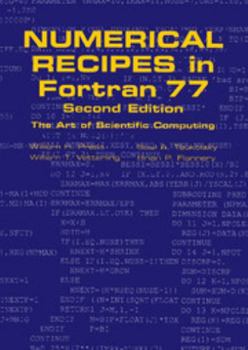Numerical Recipes in FORTRAN: The Art of Scientific Computing (2nd Edition)
(Book #1 in the FORTRAN Numerical Recipes Series)
Select Format
Select Condition 
Book Overview
This is the greatly revised and greatly expanded Second Edition of the hugely popular Numerical Recipes: The Art of Scientific Computing. The product of a unique collaboration among four leading scientists in academic research and industry Numerical Recipes is a complete text and reference book on scientific computing. In a self-contained manner it proceeds from mathematical and theoretical considerations to actual practical computer routines. With over 100 new routines bringing the total to well over 300, plus upgraded versions of the original routines, this new edition remains the most practical, comprehensive handbook of scientific computing available today. Highlights of the new material include: -A new chapter on integral equations and inverse methods -Multigrid and other methods for solving partial differential equations -Improved random number routines - Wavelet transforms -The statistical bootstrap method -A new chapter on less-numerical algorithms including compression coding and arbitrary precision arithmetic. The book retains the informal easy-to-read style that made the first edition so popular, while introducing some more advanced topics. It is an ideal textbook for scientists and engineers and an indispensable reference for anyone who works in scientific computing. The Second Edition is availabe in FORTRAN, the traditional language for numerical calculations and in the increasingly popular C language.
Format:Hardcover
Language:English
ISBN:052143064X
ISBN13:9780521430647
Release Date:September 1992
Publisher:Cambridge University Press
Length:1010 Pages
Weight:3.30 lbs.
Dimensions:1.8" x 7.3" x 10.3"
Customer Reviews
5 ratings
Outstanding reference book on numerical algorithms
Published by Thriftbooks.com User , 17 years ago
This is the single best book that I have found for teaching numerical methods in science and engineering to upper division undergraduates and graduate students. Students often comment that this should be the selected text even in the programming course because it provides both an overview of the methods and examples that demonstrate the application. The discussions are excellent and the Fortran 77 programs easy to follow even if one is more familiar with C or C++. You should not purchase the Fortran 90 version of this book without getting this book as well because the Fortran 90 book does not contain the excellent discussion of the methods and procedures. Rather it references this book for discussion and simply provides the F90 versions of the routines.
Indispensible, a classic in the field
Published by Thriftbooks.com User , 23 years ago
This volume, and its companions for other programming languages, is an absolute classic. The authors strike the right balance between cookbook solutions and theory, so that most of us get just enough background to choose the right algorithm but not so much to get drowned in theory. This edition is the first devoted only to Fortran, but is the second edition published by the authors. It includes a number of additions and corrections, many of which appeared in Computers in Physics (now the journal Computing in Science and Engineering published jointly by the IEEE and the APS). My only criticism is, where were these books twenty years ago when I needed them? I would recommend these books to anyone involved in the application of numerical methods. They are tremendous time savers.I never bothered with the discs, as most of the routines are fairly short and not a problem to type in, but I recommend the companion example books to help get the routines running.
Routines an more routines
Published by Thriftbooks.com User , 23 years ago
If you ever had to program a complicated numerical algorithm, such as SVD decomposition, Bessel functions, eigensystems or Fourier transform, you will know how useful this book is. All those problems, and many others, are presented, the theory is explained and the full code of a routine, which solves it, is given. This version brings the codes in FORTRAN 77, but there are versions for Pascal, C++ and Basic. If you need any routine, you just have to "cut and paste" it from the book into your program.
Clear explanations with good code
Published by Thriftbooks.com User , 24 years ago
I converted the authors' multigrid program on p. 870 to Visual Basic and ran it in EXCEL. Comparison with exact solutions for special cases of Poisson's equation showed it to be accurate to micro percents in less time than it takes to write the spreadsheet (a second or so). The explanation of the program in the text is clearer than specialist discussions like Wessling (An Introduction to Multigrid Methods), but doesn't contain theoretical analysis of convergence rates. Personally, I find it more persuasive to plot the errors vs number of cycles, number of smoothings etc. than to read theoretical analysis.The authors also compare various methods and give practical advice about which methods to use. Specialist texts on numerical methods aren't much good in this regard, being hung up on methods where it is easy to prove convergence rates.Bottom line: Good code, good qualitative discussion, good comparisons of methods.
Easy read about numerical processes
Published by Thriftbooks.com User , 26 years ago
I purchased the "Numerical Recipes The art of Scientific Computing" to learn more about implementing Fourier transforms into my programming applications. I hit the jackpot with this series of books. The companion workbook "Numerical recipes, Routines and Examples in BASIC" provides examples of BASIC code in a printed format. A BASIC (IBM) diskette will save a lot of time typing. Ordering information is provided in the back of the book for obtaining the accessories. The "Numerical Recipes The art of Scientific Computing" series is also available in Pascal and C programming language flavors. This book series is the mother lode for paste-in numerical data reduction and processing routines.





